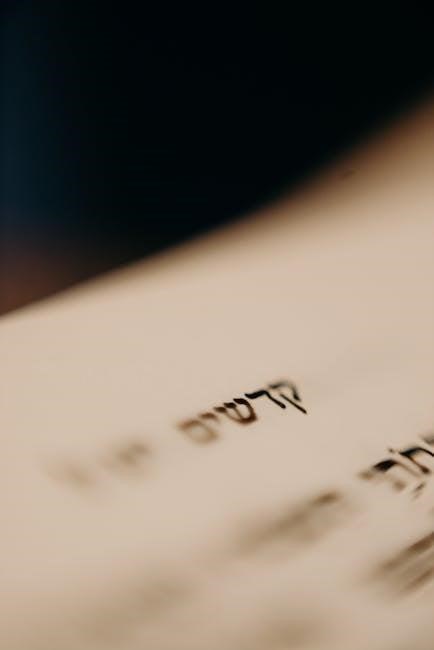The Hebrew alphabet consists of 22 consonants‚ each with unique forms and pronunciations. Final letters differ in shape when appearing at word ends‚ aiding in recognition and writing. PDF resources offer comprehensive charts‚ practice sheets‚ and flashcards‚ making learning accessible and structured for beginners and scholars alike.
1.1 Overview of the Hebrew Alphabet
The Hebrew alphabet‚ also known as the Aleph-Bet‚ consists of 22 consonants written from right to left. Five letters—Hebrew letters—have distinct final forms when appearing at the end of a word‚ aiding in recognition and proper writing. The alphabet lacks vowels in ancient texts‚ though modern Hebrew uses diacritical marks to indicate vowel sounds. Each letter carries a numerical value‚ significant in gematria. PDF resources‚ such as charts and flashcards‚ provide a structured way to learn and practice the Hebrew letters‚ making the alphabet accessible for both beginners and advanced learners.
1.2 Importance of Learning Hebrew Letters
Mastering the Hebrew alphabet is essential for understanding Biblical texts‚ prayer books‚ and modern Israeli culture. The letters hold deep historical and religious significance‚ with each carrying numerical values used in gematria. Learning Hebrew letters enables effective communication in Hebrew‚ enhances biblical studies‚ and connects learners to Jewish heritage. PDF resources‚ such as charts and workbooks‚ provide structured tools for practice‚ making the process accessible. Proficiency in Hebrew letters is vital for reading religious texts like the Torah and Talmud‚ fostering a deeper connection to tradition and language.
1.3 Evolution of the Hebrew Alphabet
The Hebrew alphabet traces its roots to the Phoenician script around 1000 BCE‚ evolving through the Paleo-Hebrew script until the Babylonian exile. Post-exile‚ it adopted Aramaic influences‚ developing into the Square Hebrew script used today. Over centuries‚ it incorporated vowel points for pronunciation clarity. Ancient forms‚ like Paleo-Hebrew‚ are now mainly ceremonial. Modern Hebrew remains vital in Israel and Jewish communities. PDF resources offer historical insights and learning tools‚ bridging ancient traditions with contemporary education‚ ensuring the alphabet’s enduring relevance and accessibility for scholars and learners alike.

Structure of the Hebrew Alphabet
The Hebrew alphabet has 22 consonants‚ written right-to-left‚ with vowels indicated by diacritics under consonants. Five letters have distinct final forms‚ and PDFs provide charts and practice sheets for learning.
2.1 List of Hebrew Letters and Their Names
The Hebrew alphabet includes 22 consonants‚ each with a distinct name and pronunciation. The letters are: Alef (א)‚ Bet (ב)‚ Gimel (ג)‚ Dalet (ד)‚ He (ה)‚ Vav (ו)‚ Zayin (ז)‚ Chet (ח)‚ Tet (ט)‚ Yud (י)‚ Kaf (כ)‚ Lamed (ל)‚ Mem (מ)‚ Nun (נ)‚ Samech (ס)‚ Ayin (ע)‚ Peh (פ)‚ Tzadi (צ)‚ Kuf (ק)‚ Reish (ר)‚ Shin (ש)‚ and Tav (ת). These letters are foundational for reading Hebrew texts‚ including the Torah and prayer books. PDF charts often list these letters with their names‚ pronunciations‚ and numerical values for easy reference.
2.2 Final Forms of Hebrew Letters
Five Hebrew letters—Kaf (כ/ך)‚ Mem (מ/ם)‚ Nun (נ/ן)‚ Pei (פ/ף)‚ and Tzadi (צ/ץ)—have distinct final forms when appearing at the end of a word. These letters change their shape but not their pronunciation or transliteration. For example‚ Kaf is written as כ in most cases and ך at the end of a word. PDF charts and practice sheets often highlight these final forms‚ aiding learners in recognizing and writing them correctly. This feature is unique to Hebrew‚ enhancing both its visual and linguistic complexity.
2.3 Pronunciation of Hebrew Letters
The pronunciation of Hebrew letters is influenced by their position in a word and the presence of vowels. Vowels are placed under consonants‚ guiding pronunciation. Some letters‚ like gutturals (א‚ ה‚ ח‚ ע)‚ are pronounced in the throat. PDF charts often include transliterations and audio guides to aid learners. Resources like flashcards and practice sheets help master sounds. Learning pronunciation is crucial for reading Hebrew texts accurately‚ and these tools simplify the process for beginners and advanced learners alike.

Hebrew Alphabet PDF Resources
PDF resources provide comprehensive tools for learning Hebrew letters‚ including charts‚ flashcards‚ and workbooks. These materials offer structured learning‚ making it easy to practice and master the alphabet.
3.1 Popular Hebrew Alphabet PDF Charts
Popular Hebrew alphabet PDF charts offer a comprehensive visual guide to learning the 22 consonants and their final forms. These charts typically include block and cursive scripts‚ along with numerical values for Gematria. Many feature vowel placements under consonants‚ aiding pronunciation. Designs vary from basic to detailed‚ catering to different learning styles. Websites like HolyHighway.info and Hebrew for Christians provide downloadable PDFs‚ ensuring accessibility. These charts are ideal for beginners‚ offering clear layouts and organized information to master the Hebrew alphabet efficiently.
3.2 Printable Hebrew Alphabet Worksheets
Printable Hebrew alphabet worksheets are essential tools for learners‚ offering structured exercises to practice writing‚ recognition‚ and pronunciation. These worksheets often include letter tracing activities‚ matching games‚ and fill-in-the-blank exercises. Many feature both block and cursive scripts‚ helping users master different writing styles. Some worksheets focus on final letter forms‚ while others emphasize vowel placement and pronunciation guides. Available in PDF format‚ they are easily downloadable from sites like HolyHighway.info and Hebrew for Christians. These resources are ideal for both classroom use and self-study‚ providing a hands-on approach to mastering the Hebrew alphabet.
3.3 Hebrew Alphabet Flash Cards in PDF
Hebrew alphabet flash cards in PDF format are a popular study aid for learners. Each card typically features a letter on the front and its name‚ pronunciation‚ and transliteration on the back. These cards are ideal for memorization and can be cut into individual cards for easy use. Available from sources like Hebrew for Christians‚ they often include both block and cursive scripts. Some sets also cover final letter forms and numerical values‚ enhancing comprehension. Flash cards are a portable and efficient way to practice and reinforce knowledge of the Hebrew alphabet anytime‚ making them a valuable resource for both beginners and advanced learners.
Learning the Hebrew Alphabet
Start by mastering the basics of Hebrew letters‚ focusing on writing and pronunciation. Practice daily using PDF charts and flashcards to build familiarity and confidence effectively.
4.1 Step-by-Step Guide to Learning Hebrew Letters
Begin by familiarizing yourself with the 22 Hebrew consonants and their final forms. Download a Hebrew alphabet PDF chart to visualize each letter’s shape and pronunciation. Start with the basics: learn the names and sounds of each letter‚ using flashcards or printable templates for practice. Next‚ practice writing the letters using PDF worksheets or handwriting guides‚ focusing on correct strokes and formations. Gradually move to pronunciation‚ using PDF resources with transliterations to aid in learning. Dedicate time to understanding the final forms of letters‚ which change when at the end of words. Use word examples from PDF materials to apply your knowledge. Finally‚ reinforce your learning with regular review and practice‚ utilizing interactive PDF exercises or quizzes to test your progress.
4.2 Tips for Memorizing Hebrew Letters
Memorizing Hebrew letters can be made easier with structured techniques. Start by downloading a Hebrew alphabet PDF chart to visualize each letter’s shape and pronunciation. Use flashcards to associate each letter with its name and sound‚ flipping them to test your memory. Practice writing letters regularly using printable PDF worksheets‚ focusing on correct formations. Group letters by similarity or pronunciation to create mental associations. Utilize mnemonics or stories to remember challenging letters. Incorporate pronunciation practice with transliteration guides from PDF resources. Lastly‚ review consistently‚ using interactive PDF exercises or quizzes to reinforce your memory and ensure long-term retention.
4.3 Common Mistakes in Learning Hebrew Letters
Common mistakes in learning Hebrew letters often stem from confusing similar letterforms‚ such as ד (Dalet) and ר (Resh)‚ or misidentifying final forms. Beginners may struggle with pronunciation‚ especially for letters like ע (Ayin) and ח (Chet)‚ which lack direct English equivalents. Another error is neglecting the right-to-left script direction‚ leading to reversed letters. Additionally‚ learners often overlook vowel placements under consonants‚ affecting pronunciation accuracy. Using Hebrew alphabet PDF charts and practice sheets can help mitigate these errors by providing clear visual guides and exercises for proper letter formation and vowel association.

Hebrew Alphabet and Gematria
The Hebrew alphabet includes a system called Gematria‚ where each letter is assigned a numerical value. This practice is used for interpretations in Jewish texts and Bible study‚ adding deeper meaning to words and phrases through numeric calculations.
Gematria is a system of assigning numerical values to Hebrew letters‚ traditionally used for interpreting Jewish texts. Each letter in the Hebrew alphabet is assigned a specific number‚ enabling deeper insights into words‚ phrases‚ and entire passages. This practice‚ rooted in Jewish mysticism‚ allows for symbolic interpretations of biblical texts and explores hidden meanings. Gematria is widely used in studying the Torah and other sacred writings‚ offering a unique lens to uncover connections and patterns. Its significance extends beyond mathematics‚ representing a bridge between language and spirituality.
5.2 Numerical Values of Hebrew Letters
Each letter in the Hebrew alphabet is assigned a specific numerical value‚ ranging from 1 (Aleph) to 400 (Tav). These values are used in Gematria to uncover hidden meanings in texts. The system allows for complex calculations‚ where words or phrases are converted into numbers for interpretation. For example‚ letters like Yud (10)‚ Hey (5)‚ and Vav (6) are foundational in such calculations. This numerical system is deeply rooted in Jewish mysticism and is often used to explore connections between words and concepts in biblical texts‚ offering a unique perspective on scriptural interpretations and spiritual insights.
5.3 Practical Examples of Gematria
Gematria involves calculating the numerical value of Hebrew words to reveal deeper meanings. For example‚ the word “Chai” (חי)‚ meaning “life‚” has a value of 18 (Chet=8‚ Yud=10). This number is symbolically significant in Jewish culture. Another example is “Av” (אב)‚ meaning “father‚” which totals 3 (Aleph=1‚ Bet=2)‚ often linked to the three patriarchs or divine attributes. Such calculations are used to explore connections between words‚ phrases‚ and concepts in biblical texts‚ offering insights into their spiritual and philosophical significance. These examples demonstrate how Gematria bridges mathematics and meaning in Hebrew studies.

Hebrew Alphabet in Different Formats
The Hebrew alphabet appears in block‚ cursive‚ and Paleo-Hebrew scripts‚ each with unique stylistic features. Block letters are bold and straightforward‚ while cursive letters flow together‚ and Paleo-Hebrew reflects ancient traditions‚ offering diverse visual representations of the same characters.
6.1 Hebrew Alphabet in Block Letters
The Hebrew alphabet in block letters is the most common and recognizable form‚ often used in printed materials and digital fonts. These letters are bold‚ straight-lined‚ and lack the flourishes of cursive scripts‚ making them easy to read and write. Block letters are standardized‚ ensuring consistency across different resources. They are widely used in educational materials‚ such as PDF charts and workbooks‚ to help learners recognize and practice the Hebrew script. Their clarity makes them ideal for beginners and for official purposes like signage and documents in Israel.
6.2 Hebrew Alphabet in Cursive
Hebrew cursive script is a fluid and connected form of writing‚ differing significantly from block letters. It is commonly used in informal settings‚ such as personal correspondence and everyday writing. Cursive Hebrew letters often have unique shapes that distinguish them from their block counterparts‚ with some letters like כ (kaf)‚ מ (mem)‚ נ (nun)‚ and צ (tzadi) having distinctive curves or loops. Learning cursive is essential for understanding handwritten texts and enhances proficiency in the language. PDF resources provide practice sheets and guides to master cursive writing‚ making it accessible for learners to transition from block to cursive scripts smoothly.
6.3 Hebrew Alphabet in Paleo-Hebrew Script
The Paleo-Hebrew script is an ancient form of the Hebrew alphabet‚ used from the 10th century BCE until the 5th century BCE. It resembles Phoenician writing‚ with distinct‚ more angular shapes compared to modern block letters. Letters like Aleph‚ Bet‚ and Dalet have unique forms in Paleo-Hebrew‚ reflecting their origins. This script is primarily found in historical texts like the Torah and inscriptions on archaeological artifacts. PDF resources offer charts and guides to study Paleo-Hebrew‚ allowing learners to explore its historical significance and aesthetic beauty‚ connecting them to the roots of the Hebrew language and culture.

Hebrew Alphabet Practice Exercises
Downloadable PDF charts and worksheets provide structured exercises for practicing Hebrew letters‚ including writing drills‚ reading practice‚ and pronunciation guides‚ ideal for learners of all levels.
7.1 Writing Practice for Hebrew Letters
Downloadable PDF charts and worksheets provide structured exercises for practicing Hebrew letters‚ focusing on accurate formation and consistency. These resources often include templates for tracing letters like Alef‚ Bet‚ and Gimel‚ as well as space for free writing. Many PDF guides highlight the distinct final forms of letters‚ such as Kaf‚ Mem‚ and Nun‚ which change shape at the end of words. Practice sheets also emphasize proper stroke order and spacing‚ essential for clear handwriting. Additionally‚ printable charts often include block and cursive scripts‚ helping learners master various styles. Regular practice with these tools enhances muscle memory and improves letter recognition and writing fluency.
7.2 Reading Practice for Hebrew Letters
Reading practice for Hebrew letters involves recognizing and interpreting their shapes and sounds in various contexts. PDF resources offer exercises that focus on reading letters in isolation and within words. Learners can benefit from sheets that highlight the placement of vowels under consonants‚ which significantly impact pronunciation. Many guides include sentences or short texts for reading comprehension‚ helping to familiarize learners with the right-to-left script. Regular practice with these materials enhances the ability to decode and understand Hebrew texts‚ making learning both effective and engaging for beginners and advanced learners alike.
7.3 Pronunciation Practice for Hebrew Letters
Pronunciation practice for Hebrew letters focuses on mastering their distinct sounds and intonations. PDF resources often include guides for guttural letters like א‚ ה‚ ח‚ and ע‚ which are pronounced in the back of the throat. Learners can benefit from drills that emphasize the soft and hard sounds of letters like כ (kaf) and פ (pe)‚ which change based on the presence of a dagesh (dot). Flashcards and practice sheets in PDF format provide clear audio cues and transliterations‚ aiding in accurate pronunciation. Regular practice with these tools helps build fluency and confidence in speaking and reading Hebrew effectively.

Hebrew Alphabet PDF Workbooks
Comprehensive Hebrew alphabet PDF workbooks provide interactive exercises‚ practice sheets‚ and drills. They include letter tracing‚ pronunciation guides‚ and quizzes‚ making learning engaging and effective for all skill levels.
8.1 Comprehensive Hebrew Alphabet Workbooks
Comprehensive Hebrew alphabet workbooks offer detailed learning materials‚ including printable templates‚ practice sheets‚ and guides for writing and pronunciation. These workbooks are designed to provide a structured approach to mastering the Hebrew letters‚ with exercises tailored for beginners and advanced learners. They often include letter tracing activities‚ pronunciation guides‚ and quizzes to reinforce learning. Many workbooks also incorporate cultural and religious contexts‚ making them valuable for those interested in the deeper meaning of the Hebrew script. These resources are widely available in PDF format‚ making them accessible for self-study and classroom use alike. They are essential tools for anyone seeking to gain proficiency in the Hebrew alphabet.
8.2 Interactive Hebrew Alphabet PDFs
Interactive Hebrew alphabet PDFs provide engaging and dynamic tools for learning the Hebrew script. These resources often feature clickable letters‚ audio pronunciations‚ and interactive exercises that allow learners to practice writing‚ reading‚ and hearing the letters in real-time. Many PDFs include quizzes‚ flashcards‚ and games to make the learning process enjoyable and effective. These interactive elements cater to diverse learning styles‚ helping users to memorize and master the Hebrew alphabet more efficiently. Additionally‚ some PDFs offer customizable settings‚ allowing learners to focus on specific letters or skills‚ making them highly adaptable for both beginners and advanced learners.
8.3 Hebrew Alphabet Practice Sheets
Hebrew alphabet practice sheets are essential tools for mastering the script. They typically include letter tracing exercises‚ writing drills‚ and blank spaces for practicing each character. These sheets often feature the 22 consonants‚ their final forms‚ and vowel placements. Many resources also include variations for block letters and cursive scripts. Practice sheets are designed for learners of all levels‚ from beginners to advanced students refining their skills. They are widely available as downloadable PDFs‚ making them convenient for self-study or classroom use. Regular practice with these sheets helps learners develop muscle memory and improve their ability to read and write Hebrew accurately. Additionally‚ some practice sheets include numerical values for Gematria‚ adding an extra layer of learning. Consistent use of these resources enhances overall proficiency in the Hebrew alphabet.

Hebrew Alphabet and Vowels
Hebrew vowels are placed under consonants‚ guiding pronunciation. Key vowels include kamatz‚ segol‚ and tzeirei‚ each altering sounds. PDF resources provide charts for vowel placement and pronunciation practice‚ aiding learners.
Hebrew vowels are essential for proper pronunciation and meaning. Unlike consonants‚ vowels are not letters but symbols placed below or above consonants. The primary vowels include kamatz‚ segol‚ tzerei‚ chirik‚ cholam‚ shuruk‚ and shva. Each vowel represents a distinct sound‚ with variations for short and long pronunciations. Historically‚ vowels were added to the text by Masoretes to ensure accurate reading. In PDF resources‚ vowel charts and practice sheets are widely available‚ helping learners master these crucial symbols. Understanding vowels is vital for reading Hebrew texts and speaking the language correctly.
9.2 Placement of Vowels Under Consonants
Hebrew vowels are typically placed below the consonant they modify‚ guiding pronunciation. This system‚ developed by the Masoretes‚ ensures accurate reading of sacred texts. In PDF resources‚ vowel placement is illustrated with charts‚ showing each consonant paired with its corresponding vowels. For example‚ the letter ב (bet) with a kamatz below becomes בָ‚ changing its pronunciation. This visual method helps learners understand how vowels alter sounds and meanings‚ making it easier to master Hebrew reading skills through structured practice materials.
9.3 Impact of Vowels on Pronunciation
Hebrew vowels significantly influence pronunciation by modifying the sound of consonants. Placed beneath the letters‚ they indicate how a consonant should be vocalized. For example‚ the vowel kamatz under ב (bet) produces a “ba” sound‚ while segol under the same letter results in “be.” This system ensures clarity and consistency in reading. The combination of consonants and vowels creates distinct syllabic sounds‚ essential for accurate pronunciation. PDF resources often include vowel charts‚ helping learners master these combinations and enhance their Hebrew reading skills effectively.
Hebrew Alphabet in Religious Texts
The Hebrew alphabet plays a central role in religious texts like the Torah‚ Talmud‚ and prayer books. Its unique letters convey sacred meanings and divine messages. PDF resources often highlight its spiritual significance‚ making it a vital tool for religious study and practice.
10.1 Hebrew Alphabet in the Torah
The Hebrew alphabet is foundational to the Torah‚ the central text of Judaism. Each letter holds spiritual significance‚ with its shape and numerical value reflecting deeper meanings. PDF resources often explore these connections‚ aiding in study. The Torah’s text‚ written in Hebrew‚ uses these letters to convey divine messages‚ making their understanding essential for religious scholars and enthusiasts alike. Learning the alphabet through such resources enriches one’s appreciation of the Torah’s teachings and historical context.
10.2 Hebrew Alphabet in the Talmud
The Talmud‚ a central text of Rabbinic Judaism‚ relies heavily on the Hebrew alphabet for its discourse on Jewish law and tradition. The precise rendering of Hebrew letters is crucial for understanding the Talmud’s complex discussions‚ as even minor variations in letterforms can alter meanings. PDF resources‚ such as Hebrew alphabet charts‚ provide scholars with tools to study these letters accurately. These resources often include historical analyses and transcription guides‚ aiding in the deciphering of ancient texts and maintaining the integrity of Talmudic scholarship.
10.3 Hebrew Alphabet in Prayer Books
Hebrew prayer books‚ known as siddurim‚ use the Hebrew alphabet to convey sacred texts and liturgy. The precise rendering of each letter is vital for maintaining the spiritual and linguistic integrity of prayers. PDF resources‚ such as Hebrew alphabet charts‚ are often used to ensure accurate typography and comprehension. These resources help worshippers and scholars alike to engage deeply with the texts‚ preserving the traditions and meanings embedded in the Hebrew letters used throughout the prayer books.

Hebrew Alphabet and Calligraphy
Hebrew calligraphy showcases the artistic beauty of the alphabet‚ with intricate designs often used in religious texts and cultural art. Traditional tools‚ like brushes‚ and modern software enhance the creative rendering of letters‚ preserving their historical charm while inspiring contemporary works.
11.1 Artistic Rendering of Hebrew Letters
The artistic rendering of Hebrew letters transforms them into visually stunning works‚ often used in religious and cultural contexts. Calligraphers employ traditional tools like brushes and modern digital software to create intricate designs. Each letter’s shape and form is meticulously crafted to convey spiritual and aesthetic significance. Famous works of Hebrew calligraphy adorn synagogues‚ prayer books‚ and homes‚ blending tradition with artistic expression. This art form not only preserves the heritage of the Hebrew alphabet but also inspires contemporary interpretations‚ making it a cherished part of Jewish cultural identity and worship.
11.2 Calligraphy Tools for Hebrew Letters
Traditional tools for Hebrew calligraphy include brushes‚ dip pens‚ and specialized nibs‚ which allow for precise strokes and flourishes. Modern calligraphers also use digital software to create intricate designs. The tools are chosen based on the desired style‚ whether for prayer books‚ art pieces‚ or decorative texts. Brushes offer fluidity‚ while dip pens provide sharp details. Digital tools enable scalability and vibrant colors‚ blending tradition with modern aesthetics. These tools help preserve the beauty of Hebrew letters while adapting to contemporary artistic demands;
11.3 Famous Works of Hebrew Calligraphy
Hebrew calligraphy is renowned for its elegance and spiritual significance‚ often featured in sacred texts like the Torah and ketubot. Notable works include illuminated manuscripts of the Haggadah and intricate designs in synagogue decorations. The Aaronic Blessing‚ rendered in Paleo-Hebrew‚ is a celebrated example. Modern artists blend traditional techniques with digital tools‚ creating vibrant pieces. These works highlight the artistic and cultural importance of Hebrew letters‚ preserved in PDF collections and exhibitions worldwide‚ inspiring both religious and artistic appreciation of the Hebrew script.

Hebrew Alphabet in Modern Usage
The Hebrew alphabet is integral to modern Israeli culture‚ appearing in technology‚ advertising‚ and design. Its unique aesthetic is used to convey cultural identity and heritage‚ blending tradition with contemporary applications. PDF resources highlight its versatility in digital and artistic contexts‚ ensuring its relevance in today’s world.
12.1 Hebrew Letters in Modern Israeli Culture
In modern Israeli culture‚ Hebrew letters are not only a foundation of language but also a symbol of national identity. They are widely used in street art‚ branding‚ and digital media‚ blending tradition with contemporary aesthetics. The alphabet’s unique script is often incorporated into design and advertising‚ reflecting Israel’s cultural heritage. Educational resources‚ such as PDF guides‚ are popular for teaching the alphabet to both children and foreigners‚ ensuring its relevance in a modern‚ globalized world. This integration highlights the enduring significance of Hebrew letters in Israeli daily life and cultural expression.
12.2 Hebrew Letters in Technology
Hebrew letters have seamlessly integrated into modern technology‚ with digital fonts like Courier New supporting their unique script. This has enabled their use in various applications‚ from educational software to digital media. PDF resources‚ such as downloadable charts and practice sheets‚ have become essential tools for learning the alphabet online. Additionally‚ Hebrew letters are encoded in Unicode‚ ensuring compatibility across devices and platforms. Their inclusion in technology highlights the adaptability of the Hebrew script in contemporary communication‚ preserving its cultural significance while embracing digital advancements.
12.3 Hebrew Letters in Advertising and Design
Hebrew letters bring a unique aesthetic to advertising and design‚ leveraging their distinctive shapes for visual appeal. Brands often use them to convey cultural authenticity or symbolic meaning. PDF resources provide high-quality templates for incorporating Hebrew script into designs‚ ensuring clarity and accuracy. The letters’ right-to-left orientation offers a creative edge in branding‚ while their historical significance adds depth to artistic projects. This blend of tradition and modern design makes Hebrew letters a popular choice for advertisers seeking to capture attention and evoke emotional connections.
